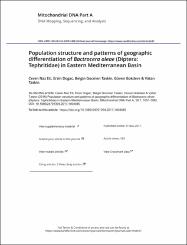Population structure and patterns of geographic differentiation of Bactrocera oleae (Diptera: Tephritidae) in Eastern Mediterranean Basin
Abstract
The olive fly (Bactrocera oleae) is the most destructive pest of olives in most commercial olive-growing regions worldwide. Significant economic damage to olive production is caused by the larvae of this fly, which feed on the pulp of Olea fruits. Studying the genetic structure of insect pest populations is essential for the success of pest management strategies. Our primary goal in the present study was to examine the population structures of olive flies collected over a wide geographic area from Turkey, a representative of eastern Mediterranean region, using two mitochondrial DNA sequences as genetic markers. The data revealed a high level of genetic variability in olive fly populations and a moderate level of genetic differentiation between Mediterranean and Aegean populations in Turkey. We also merged the sequences obtained in the present study with previously published sequences from across the world into the data matrix. Strong population substructure and a significant correlation between genetic and geographic distances were detected in northern Mediterranean basin populations of B. oleae, indicating the possibility of a westward expansion of the species in the continent. In addition, our results revealed a very close genetic relationship between the Aegean and Iranian populations, which suggests that B. oleae was introduced to Iran from western parts of Turkey. However, additional markers and analytical approaches are required to determine the exact colonization route of olive fly.


















